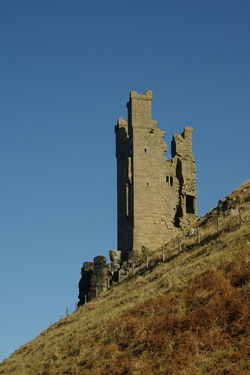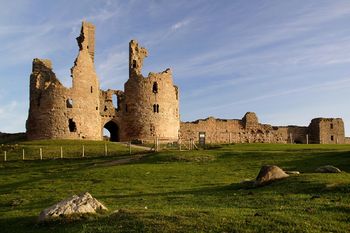Dunstanburgh Castle
Dunstanburgh Castle was founded by the Earl of Lancaster in the early 14th century. The ruins are now open to the public.
History
Dunstanburgh Castle was built in the barony of Embleton on the coast of Northumberland. Thomas, Earl of Lancaster, owned the barony and was a cousin of King Edward II. The barony was only a minor part of Thomas' estates as he also held three earldoms, those of Lancaster, Leicester, and Derby. Thomas and other magnates were jealous of the influence of Piers Gaveston in the royal court, and in 1312 Gaveston was captured at Scarborough Castle, tried, and executed. Thomas and the earl of Warwick were the main instigators of the trail. Edward II pardoned Thomas, but later records show that in May 1313 construction of the castle at Dunstanburgh was already underway, establishing a power base far from the king's centre of influence. Thomas of Lancaster was the second richest secular person in England (only the king was wealthier) and had an income of £11,000 per year. As such building a stone castle at Dunstanburgh would have been an easily absorbed by his finances.[1][2]

Dunstanburgh Castle was built on a promontory, will a harbour to the south.
In the early 14th-century, England was at war with Scotland, and in June 1314 Edward II suffered a crushing defeat at the battle of Bannockburn. In the aftermath of the battle, Edward II was heavily reliant on his cousin Thomas for the defence of northern England.[3] In 1315, two years after the first mention of construction, Thomas was granted a licence to "crenellate his dwelling-place of Dunstanburgh".[4][5]
The name Dunstanburgh was thought to be a 14th-century creation, emulating the name of nearby Bamburgh Castle however it is now thought that the -burgh suffix may refer to a previous fortification on the site. Archaeological investigations indicated that there was prehistoric or Roman activity on the site of the later castle, possibly an Iron Age promontory fort. By the time Dunstanburgh Castle was built, the area had been used as farmland for several centuries.[6] Dunstanburgh Castle was a statement of power, and would have been visible from Bamburgh Castle, a royal castle 15km away. It has been suggested that Dunstanburgh's architecture was intended to rival the castles built by King Edward I in Wales during the English conquest of the late 13th century (the likes of Caernarfon and Conwy).[7]
In 1321, a group of English barons revolted against Edward II and attacked the lands of his favourites, the Despensers. By March 1322 the rebellion was failing, and it was decided to retreat to Dunstanburgh Castle as Thomas of Lancaster was one of the baronial leaders. En route to the castle Thomas and his army were forced to face the royal army; the earl was captured at the battle of Boroughbridge and executed after a trial. Dunstanburgh Castle then became royal property, and it is thought that building work had finished by this point, although records show that maintenance was carried out over the following decades.[3][8]
Though it seems likely that Dunstanburgh Castle was not built to keep the Scots out of England, once under royal control it took on new importance in the context of border warfare. Edward II installed a garrison of 40 men-at-arms and 40 light cavalry. Because Lancaster had died as a rebel his family had not inherited his estates, and it was not until 1326 that his brother was given control of the family property. In 1366, John of Gaunt (son of King Edward III) became earl of Lancaster through marriage and was the new owner of Dunstanburgh Castle. Under John of Gaunt the most important building work at the castle since its construction was carried out. The castle built by Thomas of Lancaster was entered through a monumental two-towered gatehouse, but under John the entrance was blocked and a new gatehouse added immediately to the west. In 1399 the castle came under direct control of the king after John of Gaunt died and his son assumed the crown as Henry IV.[9]
Documents from the 16th century show that Dunstanburgh Castle was suffering from neglect.[10]
Layout and architecture

The Lilburn Tower, seen here from the south, was part of the castle originally built by Thomas, Earl of Lancaster.
The earliest part of Dunstanburgh Castle is the outer wall enclosing the site and its associated features, built by Thomas of Lancaster. Dunstanburgh Castle covers a total area of 4 hectares, making it large for a medieval castle. This may be because the castle reused surviving Iron Age fortifications to establish its limits (as can be seen at Beeston Castle in Cheshire). Only the north of the site is not protected by a wall, in this case it is because the ground drops steeply away to the North Sea. The eastern wall, facing the sea, is featureless, however there are two towers attached to the south wall (Constable's Tower and Egyncleugh Tower), and on attached the west (Lilburn Tower). In the south west corner of the circuit of walls was a monumental gatehouse and a barbican through which the castle was entered. In the late 14th century this was closed off and an alternative gatehouse built next to it. At the same time, walls were built behind the grand gatehouse build by Thomas of Lancaster, effectively creating a small enclosure within the castle.[11]
References
- ↑ Oswald, Alastair; Ashbee, Jeremy; Porteous, Katrina; & Huntley, Jacqui (2006). Dunstanburgh Castle, Northumberland: archaeological, architectural and historical investigations. London: English Heritage. p. 17. ISSN 1749-8775.
- ↑ Oswald, Alastair & Ashbee, Jeremy (2007). Dunstanburgh Castle. London: English Heritage. pp. 25–26. ISBN 978-1-905624-95-9.
- ↑ 3.0 3.1 J. R. Maddicott, ‘Thomas of Lancaster, second earl of Lancaster, second earl of Leicester, and earl of Lincoln (c.1278–1322)’, Oxford Dictionary of National Biography, Oxford University Press, 2004; online edn, Jan 2008 accessed 6 April 2013
- ↑ Davis, Philip (2006–7). "English Licences to Crenellate 1199–1567", The Castle Studies Group Journal vol 20. p. 237.
- ↑ Davis, Philip. "Dunstanburgh Castle licence to crenellate", Gatehouse Gazetteer, accessed 7 April 2013.
- ↑ Oswald & Ashbee, Dunstanburgh Castle, p. 25.
- ↑ Oswald, Ashbee, Porteous & Huntley, Dunstanburgh Castle, Northumberland, pp. 18, 56.
- ↑ Oswald & Ashbee, Dunstanburgh Castle, p. 29.
- ↑ Oswald, Ashbee, Porteous & Huntley, Dunstanburgh Castle, Northumberland, pp. 18–19.
- ↑ Ashbee, Jeremy, "Research on Dunstanburgh Castle", English Heritage, accessed 6 April 2013.
- ↑ Oswald & Ashbee, Dunstanburgh Castle, pp. 14 41.
